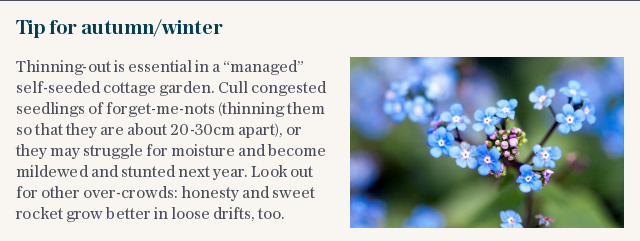Helen Yemm: benefits of seaweed; lanky roses and problems in pots
SEAWEED – A TRADITIONAL SOURCE OF NUTRIENTS
Brian Haswell from Dorset emailed me some years ago when he moved from London to the Dorset coast. He asked for advice on how best to make use of the vast quantity of seaweed that was regularly washed up on to nearby beaches, since he knew that it was traditionally valued by coastal farmers as fertiliser in the days when there was little else available to them with which to feed their soil, apart from animal manure and wood ash.
As he was messing around on the beach collecting seaweed recently, he thought about the information I gave him. He has, he says, been following my advice for a decade with fantastic results and suggests I repeat it for the benefit of other readers. So, since the stormy season is well and truly here, I have delved into my archives. Thanks, Brian, for the nudge.
Seaweed has roughly the same nitrogen, phosphate and potassium levels as horse manure, together with various minerals and trace elements – it has been used by coastal communities for centuries. To make best use of it, gardeners should concentrate on collecting fresh seaweed that has been recently washed up at or below the tide line. Wet, fresh seaweed has, surprisingly enough, a far lower salt content than the smelly, crisp stuff that has been sitting around drying on the beach in summer.
Washing seaweed before using it is not strictly necessary. Late autumn and winter is a good time of year to collect and use it as it can be dug directly into the soil to rot down during the winter. Or it can be collected and chopped up slightly and incorporated into a compost bin or heap, much as you would any ordinary garden waste. However, stacked up and stored on its own, it will inevitably get rather malodorous.

LOADS OF LANKY STEMS
I have three ‘Fred Loads’ modern shrub roses growing against a fence, providing a very airy screen. However, their stems are now nearly 10ft tall. How should they be pruned? Should I follow the accepted procedure of cutting them down by half? Linda Dixon – via email
Unlike old shrub roses, that flower once on the growth made the previous year, modern shrubs repeat-flower on the current season’s growth and can be pruned in winter – but just how far depends on what you want it to achieve.
With no picture to show me the general growth habit of your roses, it is hard to give anything but rather general advice, but if they are well established, it is probably time to cut one or two of their oldest shoots right out from the base to encourage the production of renewal shoots that will flower in the future.
‘Fred Loads’ is a naturally tall modern shrub that you could treat as a small climber: to do this you could fix a grid of wires on to your fence, then select some of the most pliable of the existing branches and pull them down to as near horizontal as possible (think of creating a fan-shape) and tie them to the grid using soft twine or Flexi-Tie.
Nip off their extremities and prune back to two buds any side shoots that flowered during last summer. Then prune by half any remaining shoots you have not trained and tied.
TWO POTTED DILEMMAS
This year Bob and Sylvia Arlett have had enormous success with a rooted cutting of a magnolia, which has already flowered in its pot (they don’t mention the variety but I am assuming it is deciduous). They are now wondering if it is time to transfer it to its intended permanent site in the ground?
It is safest to plant or transplant deciduous trees and shrubs when they are dormant, i.e. leafless. So any time this winter would be ideal, provided the ground is not frosted and can be prepared and improved with some compost and a sprinkling of bone meal. The young tree could still take a year to establish in what is likely to be a less sheltered site than it enjoyed in its pot, so may not flower well next year.
Lucy Maloney is concerned about a potted hydrangea that she has kept in a shady part of her garden for the past two years. This year the flowers have turned brown and unsightly – can I tell her what is wrong?
“Shady parts” of a garden tend also to be dry parts, and it could be that this hydrangea has been gasping for a little more moisture around its roots: and two years in the same pot is quite long enough.
All may not be lost. Lucy should try to plant it in the ground in improved soil as described above, or at least give it a roomier pot and some new compost. The unsightly flowers can be tweaked off.
Fingers crossed for a happy outcome.


